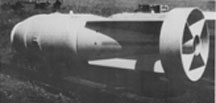Summary Facts And Figures
About The Bombs
Incendiary Bombs
In the early years of the war, the incendiaries dropped were a variant of the 50Kg bomb, and did not burn with any great intensity, so they were not particularly effective at creating fires on the ground. They also had the disadvantage of being 20 cm in diameter and weighing 50 Kg, which limited the numbers that could be carried on each aircraft. This is the type of incendiary bomb that was dropped on Bath in 1940. They were nicknamed "oil bombs".
 Incendiary bombs dropped in 1942 were quite small, weighing only a Kilogram each. The one in the picture is 5cm in diameter and about 37cm long.
Incendiary bombs dropped in 1942 were quite small, weighing only a Kilogram each. The one in the picture is 5cm in diameter and about 37cm long.
Incendiary bombs were loaded into planes in containers, and because the bombers also dropped the empty containers when the incendiaries were released, it was possible to count the empty containers and estimate how many incendiary bombs they would have held. Three different sizes of container were recovered. The largest one could hold 700, the middle size 120 and the small ones 36. This gave an estimate of 4356 incendiary bombs dropped on Bath.
Nobody counted exactly how many fell, but any that were reported by fire watchers, Civil Defence staff or the Fire Service were logged. The ones reported totalled 3681. So 675 must have fallen in places where nobody was concerned about them.
It is known from the German Air Force records that very few incendiaries were carried on the second raid. The paperwork that survived suggests that just under half of the incendiaries were dropped in the first raid, and just over half were dropped in the third raid.
The value of fire as a weapon of war is explained on a separate page.
High Explosive Bombs
High explosive bombs came in different sizes. There were small differences in construction, but they all followed the same principle.
A container for the explosive had one or two detonators to cause it to explode on impact. A tail fin kept it stable as it dropped through the air, so that it landed somewhere near where the pilot of the plane intended.
The total number of bombs that landed on Bath was about 240. The total weight of these bombs was about 129 tons.
 The main difference between the bombs dropped was their size. The smallest were 50Kg and the largest were 1,800Kg. The picture on the right shows a 1000Kg bomb, 2.5 metres long and 66cm in diameter. The 1800Kg version looked the same but was 3.75 metres long. The 50Kg bomb was small in comparison, just 1.1 metres long and 20cm in diameter.
The main difference between the bombs dropped was their size. The smallest were 50Kg and the largest were 1,800Kg. The picture on the right shows a 1000Kg bomb, 2.5 metres long and 66cm in diameter. The 1800Kg version looked the same but was 3.75 metres long. The 50Kg bomb was small in comparison, just 1.1 metres long and 20cm in diameter.
The majority of bombs dropped were either 500Kg or 250Kg, and these two sizes made up three quarters of the bombs that fell on Bath.
The Damaged Buildings
The City Engineer's Department of Bath Council conducted a street by street survey of all the damaged buildings, and produced a report listing them all by category and degree of damage. Because some of the categories overlapped (for instance, the Law Courts were listed as a Public Building and a Historic Building), the individual categories cannot simply be added to get a grand total. However, the degree of overlap is quite small, and it does not significantly affect the figures.
The City Engineer's report was later typed and published to the council four weeks following the last bombing raid. Two small lists of errors, omissions and corrections were later issued, one in July and one in August 1942.
Summary By Type
Type of building |
Number Damaged |
Historic buildings |
1906 |
Schools and colleges |
63 |
Churches and chapels |
74 |
Houses, flats and shops with living accommodation |
14564 |
Factories, workshops and industrial premises |
232 |
Hotels, shops, offices and warehouses |
679 |
Public buildings (clubs, baths, hospitals and council offices) |
116 |
Garages, sheds, stables, sports centres, conveniences |
129 |
Summary by Scale Of Damage
Amount of Damage |
Number Damaged |
Completely destroyed |
343 |
Dangerously damaged and requiring demolition for public safety |
778 |
Badly damaged and must be made safe before use |
1242 |
Badly damaged but not dangerous and can be used |
1548 |
Damaged but easily repairable and can be used |
12454 |
Broken windows or other glass only |
1383 |
If you can't find where you want to go next using the navigation buttons at the top of this page, this button will take you to the page containing the complete site index.
